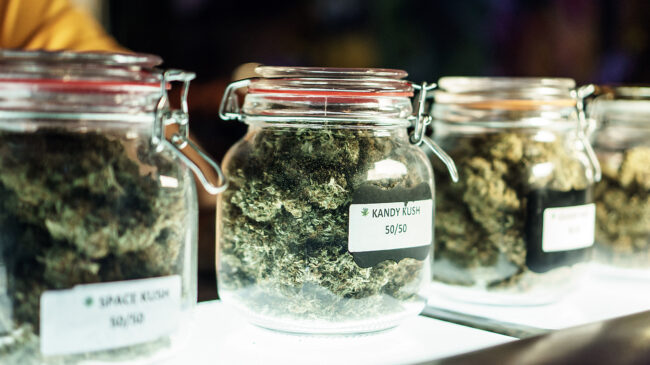On Oct. 6, President Joe Biden announced a significant and long-awaited turn in federal policy regarding the use of cannabis products. The president’s moves are important both symbolically and for the policy changes they potentially allow down the road.
President Biden’s announcement prompts a look at the fascinating economics of the rapidly-evolving U.S. cannabis industry. As of this writing, 19 U.S. states and the District of Columbia have legalized recreational or adult-use cannabis, while 19 more have legalized the medical use of cannabis products. Sales from those legal markets reached $25 billion in 2021, with that number expected to grow substantially in the coming years.
The U.S. cannabis industry is characterized by explosive growth, innovation, entrepreneurship, and extremely rapid proliferation in the number of products available. These features make it resemble the initial booms often seen in high-technology markets. However, the U.S. cannabis industry is also characterized by heavy-handed, highly inconsistent, and sometimes arbitrary regulation and taxation among the 19 states that have gone the full distance of legalizing adult use. The collision of these two factors is producing unusual results that should be of interest to economists for many reasons.
As the market matures, the regulatory regime currently in place threatens to stifle producers and retailers from offering affordable products and products consumers want. It also threatens to impede further progress in criminal justice reform and much-needed changes of course in the war on drugs.
A Bubble Inflates
The dramatic reductions in cannabis prohibition at the state level over the last decade seem to have sparked an entrepreneurial boom in experimentation that may look familiar to those who remember the wild-west days of the early internet or the more recent explosion in cryptocurrencies and blockchain-based applications.
Even two decades ago, cannabis enthusiasts who purchased the product from a dealer or friend were more likely than not to simply identify the product as marijuana. Savvy customers and growers were aware of broad distinctions, such as the two major subspecies of the cannabis plant, indica and sativa, and that cannabis from different sources might have different effects, smells, and tastes. Most marijuana sold on the black market was entirely unlabeled, so the best consumers could do in determining what was in their bag was an educated guess. The black market in marijuana was highly lucrative, but innovating and differentiating products were often not.
A baby boomer who experimented with marijuana in their youth before putting the substance down might be surprised to walk into today’s regulated medical and recreational facilities, where they would be faced with the choice of dozens or hundreds of so-called strains produced by selective breeding in the also-booming cultivation market. Choices for cannabis flower alone might include strains with names like Ghost Train Haze, Girl Scout Cookies, Facewreck, and yes, even Sleepy Joe.
While most consumers agree different strains can have different effects and tastes, the descriptions at one’s local legal dispensary can be extremely detailed but also highly subjective, without any single or a small number of trusted sources to verify or standardize these claims. We are told, for example, that for Ghost Train Haze, “low doses are conducive to concentration and creativity, but you may notice some cerebral haziness as you smoke more.” Girl Scout Cookies marijuana apparently “catapults you into a wave of euphoria and tingles that encapsulate your body with very little effort. These ultra-powered buds will have you questioning space and time, while utterly gluing you to your seat.”
Just how many strains are there in 2022? Industry watchers appear to have lost count. “Over 700” is a figure often cited in the media. Cultivator and distributor Cresco Labs, on its blog, puts the number at “over 1,000.” Popular cannabis site Leafly lists over 3,600 known strains in its database.
We still haven’t discussed the equally explosive proliferation of other types of cannabis products. Vaping (with parallels to a phenomenon in the nicotine market), has become popular through a wide array of different devices. Concentrates, relatively new on the scene, have become a major part of regulated dispensaries’ businesses, offering a host of different highly concentrated forms of THC potent enough that they are often not recommended for inexperienced users. Edibles, once associated with brownies made in a friend’s kitchen using leftover pot, are booming as well, with accurately labeled THC content and available as hard candy, gummies, chocolate, and beverages, to name a few. Finally, along with this boom has come a vast proliferation of cannabis accessories, from regular glass and water pipes to all manner of devices to vaporize cannabis flowers, THC oil, and concentrates.
Many will look at this exponential growth in cannabis varieties accompanied by vague or dubious information about effects, not to mention a steady stream of new and expensive gear, and immediately think “bubble.” They are most likely correct. However, this needn’t be a bad thing or a sign of egregious errors made by entrepreneurs or investors. Entrepreneurs must experiment and compete in the market to learn what products consumers most want.
But while the peculiar combination of U.S. cannabis legalization along with heavy-handed regulation may have been conducive to the experimentation phase of market discovery, the different regulatory hoops firms must jump through in different states may present big problems as the newly legal market attempts to consolidate what it has learned from this initial experimenting.
A Discovery Process Interrupted
The specific regulations and taxes that cannabis vendors face differ widely among the 19 states where cannabis use is currently fully legal. While some states have done a far better job at allowing a dynamic and affordable market than others, a constant is that cannabis is not yet treated like any other consumer product.
Even classic so-called vice products like tobacco and alcohol, heavily regulated, can be found in special sections of gas stations, grocery stores, and Walmart (in most states). Consumers may have to show identification and navigate quirky legacy rules in some states, like not purchasing alcohol on Sundays. But shopping for alcohol and tobacco still mostly resembles the shopping experience to which American consumers are accustomed.
In virtually all states with legal recreational cannabis, the only way to buy that legal product is through dispensaries, usually small businesses that have gone through the state’s detailed if not arduous licensing process. Smoke and vape shops often specializing in selling all those new accessories usually do not qualify, and your local grocery store or Walmart will likely not have a cannabis section in any state any time soon.
While sales taxes charged by states are highly varied, they almost always exceed those charged on virtually any other product. Tax regimes by states are a labyrinth of different rules and formulae, making comparisons difficult. Reason Foundation’s Geoff Lawrence and Spence Purnell estimated an apples-to-apples comparison of the taxes someone would pay on a pound of marijuana bought at retail, and the differences across states are striking. Illinois, the highest-taxed state at the time, charged more than double the tax of Michigan, only a short drive away.
Tax rates are not the only reason for high state-to-state variation in prices. Even before state tax, Lawrence and Purnell’s estimates of retail prices are higher in Illinois than in Michigan. What explains this gap beyond sales tax?
Michigan’s licensing process for legal marijuana dispensaries is far more open than Illinois’. The somewhat startling result is that Illinois has 110 retail stores working with 21 growers, while Michigan has close to 500 recreational marijuana stores working with over 1,000 growers. As The Chicago Tribune notes, Illinois may have had the best of intentions in its highly micromanaged licensing process, but has failed in practice:
“Illinois was the first state to open a legal recreational market through legislation. That meant that lawmakers could write the law to promote greater diversity. But the law allowed a few existing medical cannabis companies to dominate the market. They got a nearly three-year head start selling adult-use pot while social equity applicants were delayed.”
Both states appear to be taking steps to moderate their licensing processes, albeit in different directions. In July 2022, Illinois issued 185 new recreation licenses, in theory, more than doubling such dispensaries in the state, though those businesses are yet to open. Meanwhile, Michigan recently proposed a moratorium on new marijuana business licenses due to prices plummeting below levels where the business model can be sustained. Michigan’s cannabis consumers will still be served, though. In the fall of 2021, Ann Arbor, home of the University of Michigan, already had 24 operating dispensaries, while Champaign-Urbana, home of the University of Illinois, had four dispensaries.
States are only now beginning to take steps to integrate cannabis with the existing retail market. Licensed dispensaries are almost all the same business type—small storefronts offering little or no shopping experience and highly restricted from selling non-cannabis products. This may be starting to change. Circle K and Green Thumb Industries recently announced a partnership to open medical dispensaries alongside 10 convenience stores in Florida. Leveraging both economies of scale and scope, such businesses may be far better equipped at times to service fast-growing cannabis markets at lower prices.
This patchwork of fragmented state markets with high and complicated taxation and heavy-handed restrictions on who may and may not enter the industry will likely become a bigger problem as cannabis continues to become mainstream, more states legalize, and the market matures. It may have been relatively conducive to an experimental “wild west” phase of a market discovery process, but whether through bursting bubbles or smaller and slower corrections, a phase of consolidation is needed for a well-functioning market that provides affordable products that consumers want.
Consider also the impact of sticking with a heavy-handed state-by-state regime on issues of criminal justice and equal access. In 2021, a whopping 70 percent of cannabis transactions in Illinois remained on the illicit market. Especially in the states that have legalized it but have high taxes and prices, many cannabis users simply cannot afford current legal marijuana prices at dispensaries. This population is also more likely to receive unfair outcomes in the criminal justice system. More small storefront dispensaries help, but especially as experimentation turns to consolidation, offering cannabis products at lower prices may be best handled by the types of businesses, like large retailers in many states that keep liquor in a special section and check IDs.
President Biden has no power to harmonize or end state regulations, but the changes he announced at a national level are an occasion to take a hard look at how cannabis markets in the United States are evolving. Moving marijuana to a regulatory regime similar to alcohol will likely face substantial resistance. Some states will not want to appear soft on crime and drug use, let alone give up large sales tax rates. Cannabis growers and dispensary owners, who have often taken on an organic and localist aesthetic—and have now become the privileged licensed class in the industry—will howl at the thought of trying to compete with Walmart offering a budget line of marijuana.
Progress related to marijuana legalization has been undeniable in recent years, and Biden’s announcement was a welcome one for cannabis users and entrepreneurs, as well as many others who care about criminal justice reform and ending the war on drugs. Ad hoc state markets, over-taxed and over-regulated, may have been the appropriate first phase for cannabis legalization in the United States, but a market that looks more like other products will soon be indispensable.

